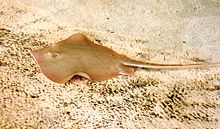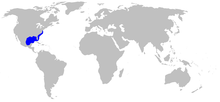Atlantic stingray
| Atlantic stingray | |
|---|---|

| |
| Scientific classification | |
| Domain: | Eukaryota |
| Kingdom: | Animalia |
| Phylum: | Chordata |
| Class: | Chondrichthyes |
| Subclass: | Elasmobranchii |
| Superorder: | Batoidea |
| Order: | Myliobatiformes |
| Family: | Dasyatidae |
| Genus: | Hypanus |
| Species: | H. sabinus
|
| Binomial name | |
| Hypanus sabinus (Lesueur, 1824)
| |

| |
| Range of the Atlantic stingray | |
| Synonyms[2] | |
| |
The Atlantic stingray (Hypanus sabinus) is a
industry.Taxonomy and phylogeny
The Atlantic stingray was described by French
A 2001 phylogenetic analysis by Lisa Rosenberger, based on
Distribution and habitat

The Atlantic Stingray is found in the western
This species inhabits shallow coastal waters over sandy or silty bottoms, estuaries, and lakes. They prefer water temperatures over 15 °C (59 °F) and can tolerate temperatures over 30 °C (86 °F). These stingrays conduct seasonal migrations to stay in warmer water: they are only present in the northerly Chesapeake bay in the summer and fall, and elsewhere they migrate to deeper water in the winter. When inshore, they usually stay at depths of 2–6 m (6.6–19.7 ft), and after migrating offshore they may be found as deep as 25 m (82 ft).[3]
Description
One of the smallest stingray species, the Atlantic stingray attains a maximum length of 61 cm (24 in) and a weight of 4.9 kg (11 lb).
Larger Atlantic stingrays develop tubercles or thorns along the midline of the back to the origin of the tail spine. Some larger females also develop tubercles around the
Biology and ecology

The Atlantic stingray feeds mostly on
Despite having a regular freshwater presence, the Atlantic stingray is physiologically
Like other stingrays, the Atlantic stingray is
Human interactions
If stepped on, the Atlantic stingray can inflict a painful, though rarely life-threatening wound. Large numbers of Atlantic stingrays are caught as
References
- ^ . Retrieved 26 May 2023.
- ^ Bailly, Nicolas (2017). "Hypanus sabinus (Lesueur, 1824)". WoRMS. World Register of Marine Species. Retrieved 11 July 2023.
- ^ a b c d e f g h Passarelli, N. and Piercy, A. Biological Profiles: Atlantic Stingray. Florida Museum of Natural History Ichthyology Department. Retrieved on March 9, 2009.
- ^ a b Froese, Rainer; Pauly, Daniel (eds.) (2009). "Dasyatis sabina" in FishBase. March 2009 version.
- ^ Lesueur, C.A. (1824). "Description of several species of the Linnaean genus Raia, of North America". Journal of the Academy of Natural Sciences of Philadelphia. 4 (1): 100–121.
- ^ Bigelow, H.B. and W.C. Schroeder (1953). Fishes of the Western North Atlantic, Part 2. Sears Foundation for Marine Research, Yale University. pp. 370–378.
- S2CID 85657403.
- ^ ISBN 978-0-292-75206-1.
- ^ S2CID 1980147.
- ^ Johnson, Michael R.; Snelson Jr., Franklin F. (1996). "Reproductive Life History of the Atlantic Stingray, Dasyatis Sabina (Pisces, Dasyatidae), in the Freshwater St. Johns River, Florida". Bulletin of Marine Science. 59 (1): 76.
- ^ Murch, A. Atlantic stingray. Elasm-diver.com. Retrieved on March 8, 2009.
- JSTOR 1445395.

